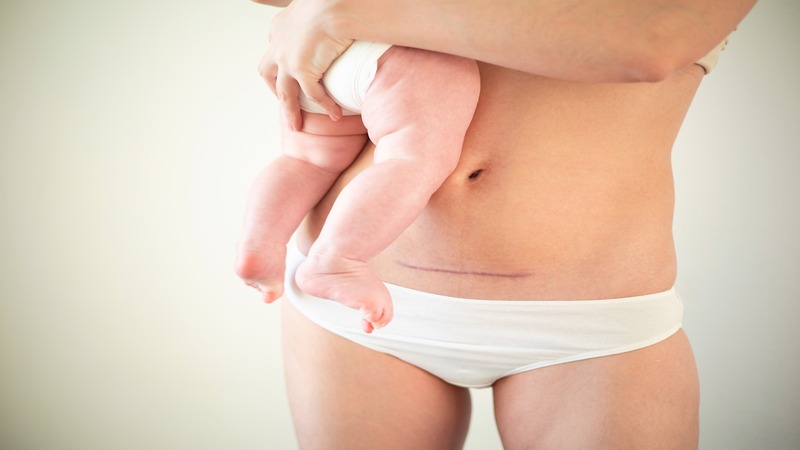
Vaginal births are most always the most desired birthing experience of every expecting mother owing to relatively easy recovery and many other benefits. Unless there are some dire situations where cesarean section becomes the safe option for childbirth, or some other personal preference, natural, vaginal birth is considered the best and safest.
- What Is A C-Section Birth?
- 10 Most Common Reasons Of A Cesarean Delivery
- What Are The Risks of A C-section Delivery
- How To Expedite Recovery From A C-section?
What Is A C-Section Birth?
Cesarean section or C-section, lower segment cesarean section or LSCS is defined as a surgical procedure done to deliver the baby by giving a planned incision on the abdomen and uterus of the mother. The baby in this process is not born vaginally, but through the abdomen. C-section can be planned in advance if complications are associated with pregnancy. A planned C-section, a planned repeat C-section or a complicated pregnancy may result in a C-section delivery. The incidences of C-section have seen a surge in the last decade, with more than 1 in 4 women likely to give a birth through a cesarean. Women also opt for an elective cesarean for personal preferences even when they have a good chance of having a vaginal birth.
10 Most Common Reasons Of A Cesarean Delivery
Below are listed some of the most frequent conditions where c-section becomes the ultimate choice.
- Nonpressing labor: Stalled labor or non-progressing labor is the commonest of all reasons for undergoing a cesarean section. If in spite of uterine contractions, your cervix is not responding well or not dilating as required, the labor is termed as stalled labor. If the baby’s head is stuck and is not descending down, the oxygen supply to the baby is hampered and this can be lethal for your baby. Going for C-section is the only way left to save the life of the baby
- Position of the baby: The position of the baby in the uterus is another factor determining the probability of C-section. If the baby is in transverse (sideways) position or lies in a breech presentation, the cesarean section is safest method to deliver the baby. Again, if changing the position is not recommended or it has failed, C-section would be the first choice
- Multiple babies: C-section becomes the best choice in case of twin or multiple pregnancies as the chances of abnormal position of one of the baby is more common. This is especially if the first baby is not in a heads-down position
- Placenta previa: Placenta provides nourishment to the growing fetus and is formed from maternal and fetal tissues. Usually it is present behind the fetus attached to the uterine wall, but sometimes it may be found to cover the cervical opening, this condition is called placenta previa. C-section is the best option in placenta previa for safe childbirth
- Umbilical cord: The umbilical cord is composed of Wharton’s jelly that is attached to the placenta on one end and fetus on the other. Sometimes a loop of cord slips out through the cervix (cord prolapsed) in front of the baby and this cord gets compressed during uterine contractions. Cord compression is serious as it affects baby survival. In such a situation, the cesarean section should be done for the safety of the fetus
- Maternal health: If the pregnant mother is having any serious ailments such as cardiac disease, asthmatic, hypertensive, etc. she will be advised for a C-section delivery. If an infection such as herpes or HIV is present, vaginal delivery is not preferred as there are chances of passing on the infection to the baby during delivery. gestational diabetes and pre-eclampsia also increases the chances of having a c-section delivery
- Mechanical obstruction: The presence of mechanical obstructions such as large uterine fibroid, displaced fracture of pelvis bone, hydrocephalus baby, etc. are some of the common conditions where C-section becomes the best alternative. An unsuccessful attempt at using forceps or ventouse will also result in a C-section.
- Previous C-section: If the baby born was delivered by a cesarean section, then the probability of subsequent birth via C-section is slightly high. If the reason for your previous C-section is not there in the current pregnancy, then you can opt for VBAC after consulting the doctor
- Unplanned C-section for baby in distress: A traumatic vaginal delivery attempt coupled with the baby becoming distressed would result in an unplanned C-section
- Uterine rupture: If in the course of delivery the scar from a previous C-section opens up or tears, and emergency C-section is performed. This is not a common condition and the incidence is very low
- Some women straight away opt for C-section in order to avoid any probable complications of vaginal delivery.

What Are The Risks of A C-section Delivery
There are some risks related with C-section for example:
- Recovery takes long time as compared to vaginal delivery
- Babies born with the aid of C-section are more prone to suffer from transient tachypnea
- There is a risk of baby’s skin getting accidental nicks during C-section
- More blood loss occurs with cesarean section than vaginal delivery
- Endometritis or inflammation of the internal lining of the uterus is common with C-section
- In some patients adverse reaction of the body to the anesthesia administered is also reported
- The chances of developing blood clot within a vein are also common with C-section. Early ambulation is therefore recommended after cesarean section
- In contrast to vaginal deliveries, wound infection is more frequent with C-section around the uterus or the incision line
How To Expedite Recovery From A C-section?
Here are some simple tips to help you have a speedy recovery after C-section.
- Rest: Rest is a very important factor for a speedy recovery. Keep everything within your reach so you do not have to waste time in finding things needed for yourself and your baby
- Avoid lifting weights: Do not sit in squatting position or lift heavy objects at least for first 6 to 8 weeks post-C-section
- Abdominal support: Wear an abdominal belt or support your abdomen with a broadcloth belt in order to avoid exerting unwanted pressure on your C-incision. You can use a pillow to support during breastfeeding your baby
- Have plenty of fluids: Drink plenty of fluids to replenish the fluid lost during breastfeeding and delivery. Fluids also regularize the stive system and prevent constipation. So drink at least 10 to 12 glasses of water every day
- Avoid sex for some time: Sex is usually avoided after C-section for at least 6 to 8 weeks. Spend time with your spouse as it will strengthen the intimate emotional bonding
- Ambulation: Avoid being sedentary as this slows down the healing process. Gentle walks in the morning or evening as per your convenience should be done
Keep these simple tips in mind and the post-C-section phase will be hassle-free! Read more about C-section infection and Tips For Speedy C Section Recovery as well.
